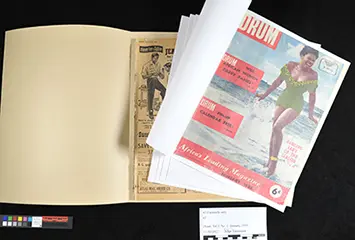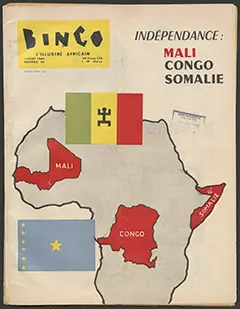Herskovits Library loans out delicate artifacts for 1960s Africa exhibition

Physical and digital materials from the Melville J. Herskovits Library of African Studies formed a significant contribution to a spring exhibition at the University of Chicago’s Smart Museum of Art—with a major assist from the Libraries’ conservation lab.
An exploration of mid-20th-century African life as documented through photography, not all realisms: photography, Africa, and the long 1960s featured 67 physical objects on loan from the Herskovits collection. Along with 11 digital reproductions of Northwestern materials, these contributions made up about half of the exhibit.
Esmeralda Kale, the George and Mary LeCron Foster Curator of the Herskovits Library, noted that the exhibition curator’s eclectic selections—ranging from South African government pamphlets to lively works by Malian photographer Malick Sidibé, who chronicled West African life—prove that still images offer viewers many ways to interpret meaning.
“An image of a 1960 protest can be used in one context in a poster and reused in a different way in a magazine,” she said. “A photograph can be appropriated and its meaning changed from one use to the next.”

Receiving an exhibit curator’s list of requested items is only one step in the loan process. A conservator needs to assess any object’s condition before it can be loaned. Because so many of the requested materials were on brittle media, it was the Libraries staff’s expertise that made much of the exhibition possible.
Many of the magazines and newspapers were on newsprint, “a cheap paper made for short-term use. Over time it becomes darkened and brittle,” said chief conservator Susan Russick, whose team treated each item to stabilize it for display.
Complicating matters was the binding of the magazines. Senegal’s Francophone magazine Bingo and South African Black lifestyle magazine Drum had been bound years ago when their paper was still flexible, but the pages eventually became susceptible to breaking loose. Russick and her team disbound them to facilitate their treatment and display.
To aid in exhibiting these delicate materials, the conservation team created more than 50 customized cradles and other mounts for positioning items on display and protecting them from damage during transport and installation.